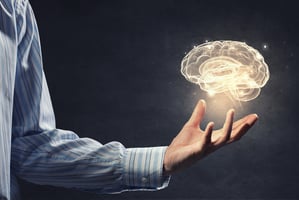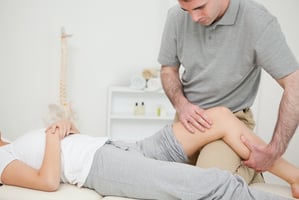What are the Effects of Stroke?
The Problem of Post-Stroke Fatigue
One effect of this life-changing event, what is it and how to manage its widespread impact?
Stroke can be life changing. Recent news of popular BBC journalist Jennie Gow’s stroke at the relatively young age of 45 raises awareness that stroke can happen to anyone at any age. Stroke can result in a wide variety of symptoms and no two strokes are exactly the same. This blog will explore fatigue, one of the many symptoms it is possible to experience.
Fatigue
Fatigue, following any type of stroke, can be debilitating due to the affect it can have on your ability to participate in rehabilitation. It can also have a widespread, direct and indirect impact on all areas of your life from completing the simplest of tasks, such as putting on your shoes, to returning to work or managing relationships with family and friends. With a good understanding and the right support fatigue can improve over time but education and knowledge are key!
Understanding post-stroke fatigue and how it differs from normal tiredness
Post-stroke fatigue is not the same as normal tiredness as it won’t simply get better or resolve with a rest or sleep. Often when we feel tired, we will try to have an early night to help, however, post stroke fatigue differs in that you may not feel better even after a full night’s sleep. Even the simplest of tasks such as getting dressed may require a lot of energy and cause extreme tiredness that a rest will not necessarily address.
Individuals experiencing post-stroke fatigue often describe it as having a lack of energy or increased need to rest every day or nearly every day. It can present physically, mentally, and emotionally and can make it difficult for you to take part in everyday activities. For example, it can impact on your ability to complete day-to-day tasks, attend work, socialise, and complete leisure activities. It can also have an effect on your ability to engage in rehabilitation and can therefore have a significant impact on your stroke recovery. If left unaddressed post-stroke fatigue can decrease your quality of life and increase your dependency on others.
Post-stroke fatigue may not go away altogether, but it can get better over time. Accessing the right support and implementing appropriate strategies to manage the impact of fatigue can help you to continue to lead a normal life.
What causes post-stroke fatigue?
There is no definitive cause of post stroke fatigue and the research on causes is uncertain and often conflicting.
The physical affect of stroke on your brain and body can trigger fatigue, when in the coming weeks and months after a stroke your brain and body are still healing. Fatigue may be the result of direct damage to the brain system that, for example, maintains alertness, or due to other factors such as thinking and moving requiring more effort.
The Stroke Association explores how the body uses energy differently after a stroke. For instance, moving around will require more energy if one of your legs has become weak/difficult to move. Alternatively, if your arm has been affected it will require more effort to utilise it for routine tasks like dressing and cooking therefore using up more energy than these tasks would have done prior to your stroke.
Secondary conditions because of your stroke such as pain, sleep disturbance, and impaired sensation could also lead to fatigue. For example, it often requires a lot of physical and emotional energy to manage pain and this can result in energy banks being quickly drained.
Furthermore, fatigue after stroke could also be the result of emotional factors. Grief, depression, anxiety, and other emotional changes after stroke can each contribute to fatigue in their own way.
It should also be noted that it is always important to involve a professional to rule out other causes of fatigue that may not be related to your stroke such as side effects of medication.
How Might Post-Stroke Fatigue Affect You?
Post-stroke fatigue can have physical, mental, and emotional symptoms:
- Physical Fatigue: heavy limbs, aching muscles, and clumsiness; typically felt after physical exertion or exercise.
- Mental/Cognitive Fatigue: lower concentration, harder to "think" and make decisions. This might cause confusion and misunderstandings with others which in turn can affect how you feel about yourself.
- Emotional Fatigue: can affect feelings, thoughts, and behaviours. This can result in, for example, lingering thoughts, worrying, crying a lot, low mood, being irritable, or becoming angry. This in turn may cause trouble communicating with others and lead to being misunderstood.
What Next? … reducing the impact of fatigue on your stroke recovery and day to day life, what the evidence base says
There is little evidence for effective treatments for post-stroke fatigue. The Royal College of Physicians 2016 National Clinical Guideline for Stroke acknowledges the lack of high-quality evidence for fatigue treatments, making the following key recommendations:
- People with stroke who are medically stable but who report fatigue should be offered an assessment for mental and physical factors that may be contributing, particularly when engagement with rehabilitation or quality of life is affected.
- People with fatigue after stroke and their family/carers should be given information, reassurance, and support to identify their personal indicators and triggers for fatigue and supported to develop strategies to anticipate and manage fatigue.
Some pharmacological interventions (antidepressants or stimulants), psychological interventions and physical training are potential treatments if completed alongside vigorous evaluation but the National Clinical Guideline for Stroke advises there is insufficient evidence to recommend any specific intervention.
For more information on the evidence base and guidelines please follow the links below:
https://www.stroke.org.uk/sites/default/files/fatigue_after_stroke.pdf
Your Journey to Managing Post-Stroke Fatigue
- Educating yourself and others
Having a clear understanding of what post-stroke fatigue is, how it presents and impacts on you is crucial to managing fatigue. It is also useful to involve close family and friends so that they understand that fatigue is different to normal tiredness and are aware of how fatigue may impact on your ability to participate in normal roles and activities with others.
- Understanding how post-stroke fatigue affects you
Once you have an understanding of what post stroke fatigue is, the next step is to be aware of what post-stroke fatigue feels like for you, and how it impacts on your day-to-day life.
Post-stroke fatigue can present differently for different individuals and can be mild to severe. Often the individual will report feeling constantly tired, having no energy to complete day-to-day tasks which often includes self-care.
Your stroke specialist therapist will work with you to explore what fatigue means to you, how it feels for you and help you to identify your signs of fatigue. Using a visual representation of fatigue can sometimes be a useful tool to support you in understanding how fatigue impacts on you and for educating others. For example, using a battery analogy depicting that certain tasks drain batteries more than others and so there will be a need to recharge again after these tasks. Sometimes mapping out your physical presentation of fatigue on a body chart can be a useful tool to enable you and others to fully understand the impact of fatigue and the early warning signs to look out for.
Examples of fatigue symptoms could be as follows:
- eyes feeling heavy and tired
- feeling distracted/disorientated
- slower to think or process things
- reduced concentration
- yawning
- twitchy eyes
- feeling easily irritated
- weakness
- lower appetite
- altered speech (slight slurring, mixed up words)
- dizziness
- increased memory difficulties
- altered judgement
- decision making difficult
- being tearful
- wanting to sleep
- head feeling fuzzy
- headaches
Consider identifying what functional activities require which types of energy i.e. physical, mental/cognitive, or emotional. How does this impact on you? Are there any early warning signs?
- Identifying patterns/themes and triggers
Once you are aware of how fatigue feels for you and a list of the early warning signs, you can begin to explore any triggers and themes with your stroke specialist therapist. Understanding what your exacerbating triggers are for your fatigue is an important factor in managing your fatigue. Your specialist stroke therapist will support you to use several resources to enable you to identify themes and patterns and a potential list of triggers, helpful and unhelpful factors and any mediating factors. This might be, for example, through use of a fatigue diary, self-assessment scale and/or questionnaires.
It is important to note the impact of a busy day as it may not always be evident immediately. There may be occasion where you notice that certain tasks impact your energy levels more significantly over the following day or two.
- Self-Monitoring
Continued self-monitoring is essential to break the cycle of making the same mistakes, such as pushing through fatigue, as this is often not helpful or productive and you will continue to allow fatigue to have an over-bearing impact on activities that you enjoy. Through self-monitoring you can reduce the bouts of ‘Boom or Bust’ where you have the feeling of complete exhaustion. Your specialist stroke therapist will support you to identify the right tools, such as a fatigue severity scale or traffic light system, that works for you to help you to self-monitor. This may also include involving family/carers to assist with monitoring your fatigue levels.
Knowing your early warning signs of fatigue is crucial to enable you to act at the right time, rather than when it’s too late, which can result in fatigue having a more overbearing impact on your whole day or even the next day. What action to take will be discussed in the next section on pacing where strategies for managing post-stroke fatigue will be explored further.
Self-ManagementSelf- management of post-stroke fatigue can be achieved through focusing on implementing the three P’s – pace, plan and prioritise.
Pacing
Avoid exerting too much energy; instead, take frequent rests so you can resume or continue the activity for longer. Before the intensity of the symptoms worsens, pay attention to your body and those early warning indicators and act right away.
If you take regular rest breaks even when not tired, you will top up your energy throughout the day so that your energy doesn’t get too low. This will help to minimise or even prevent your fatigue symptoms. To top up energy well, you need to give your brain a break. Resting is not done by reading or watching TV. Consider finding a peaceful place to sit or lie down. You might discover that you only need 2 to 5 minutes of rest, whereas other people may require more. Completing a relaxation technique in your head may be helpful if you find it difficult to do nothing. Your stroke specialist therapist can help with this.
Prioritising and delegation
It can be helpful to identify tasks and activities that need to be completed and categorising them into whether they are meaningful to you or not and whether they are hard or easy (short or long) to complete (you may find it helpful to use a table or list to do this).
- Consider delegating those tasks that are not meaningful to you and are hard to complete.
- Those that are hard to complete but meaningful to you will need to be planned with appropriate rest breaks and consideration of what other activities you have that day. How you could break the task down, and what time of day is best for you? Could someone assist and it still be meaningful?
Another method may be to focus on activities you enjoy completing and prioritise them in order of importance to you and whether you find them easy or hard to complete. Again, those tasks that are hard to complete need to be planned appropriately, consider breaking the task down into smaller tasks and plan where you need to fit in rest periods.
Planning
To manage fatigue, planning and setting priorities are crucial. This calls for planning ahead, using a diary or calendar, and spreading out your desired activities. Don’t try to do too much in one day. While doing this, schedule regular rest breaks into your calendar. Don't wait until you are exhausted before taking a break. Consider organising any items needed before an activity (e.g., dressing) then before you start the activity take a short break. Think about it as balancing your own internal resources (physical, cognitive and emotional energy) and the demands on you.
Consider whether there are any activities/tasks that you have found increase your energy levels. This can sometimes be something that you enjoy and makes you feel uplifted or energised such as listening to music or having a short stroll. It may help to add in these types of energising tasks between tasks that tend to deplete your energy.
Additionally, switching from a task that has a high demand on cognition to one that requires a different type energy such as physical energy should be considered. This would involve bringing in your self-awareness and self-monitoring skills that you have mastered to assist with planning as you will be aware of what type of energy is required for said task and how much.
Lastly, when planning you need to consider the impact that other factors have on your energy levels, such as the environment, noise, lighting, time of day.
Other factors to consider in managing fatigue
A healthy lifestyle is key to fatigue management. You need to aim for:
- good sleep levels
- healthy diet
- appropriate exercise
Your specialist stroke therapist can help you to understand the role and importance of these areas further and how to incorporate appropriate exercise into your daily routine, ensure you have a healthy diet and advise about sleep hygiene. Your therapist will also be able to explore graded activity to build up stamina and exercise levels if you are deconditioned.
Other factors such as pain, medication and other health problems can also have an impact on fatigue and will need to be addressed with the appropriate professional to limit the impact on fatigue.
In summary, there are a lot of interventions and methods available to help minimise or even eliminate, the problems of post-stroke fatigue.
Please see our website for more information on how stroke and neuro therapists can help you:
https://www.strokeandneurotherapy.co.uk/
You may also be interested in our other blogs about the effects of stroke...
Effects of stroke: https://www.strokeandneurotherapy.co.uk/stroke-and-neuro-therapy/possible-effects-after-a-stroke
Weakness: https://www.strokeandneurotherapy.co.uk/stroke-and-neuro-therapy/stroke-weakness
Balance: https://www.strokeandneurotherapy.co.uk/stroke-and-neuro-therapy/reduced-balance
Spasticity: https://www.strokeandneurotherapy.co.uk/stroke-and-neuro-therapy/spasticity-after-stroke
Please see the stroke association website for more information on fatigue and other effects of stroke:
https://www.stroke.org.uk/effects-of-stroke/physical-effects-of-stroke
Back to top





